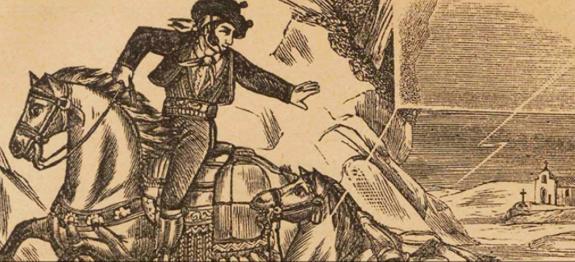The cunningness of Diego Corrientes: El Bandolero Generoso
Little trustworthy evidence exists concerning the short life of the celebrated bandit from Utrera, other than overly romanticised tales regarding his ability to outwit Don Francisco de Bruna, the sheriff sent to capture him
TONY BRYANT
Viernes, 20 de agosto 2021, 10:27
The notorious highwaymen have long been an iconic image of 18th and 19th century Andalucía, romanticised by numerous writers and artists who used them in their works to create mystery and excitement. However, others questioned these gallant highwaymen, instead depicting them as vicious thieves and murders who made their living at the inconvenience of the rich and the aristocracy.
One of the most legendary was Diego Corrientes, an 18th century bandit who earned the nickname of El Bandolero Generoso (the generous bandit). Corrientes was said to have been the most valiant and noble highwayman to have roamed the Sierra Morena. He was tall, strong and robust, and yet he never killed or harmed those he robbed. He became the most wanted man in Andalucía, but his generous nature made him popular with the peasants. His affection for the poor land workers may well have stemmed from his own upbringing, for Corrientes had worked the land before engaging the life of an outlaw.
Diego Francisco José Bernardo Corrientes Mateos was born in Utrera, a town in the province of Seville, on the 20 August 1757. He is said to have robbed more than one thousand stagecoaches on the Camino Real between Seville and Madrid. So concerned was the government of King Carlos III, it was deemed necessary to send renowned sheriff Don Francisco de Bruna to Seville specifically to tackle the problem.
There is little evidence of his short life, other than the gloriously romanticised version created by the legend, which is based on tales of his cunningness and generosity to the poor - and of his long-time rivalry with his arch-enemy Don Francisco.
In the countryside that surrounds Utrera, in the area of La Estación de Alcantarilla, there exists a crumbling old tower known as El Torre de Diego Corrientes: it is here that the ruthless hostility between Corrientes and Don Francisco is said to have begun.
Wise and informed
Corrientes was said to have been far wiser and more informed than the sheriff gave him credit for. The highwayman had become aware of Don Francisco's declaration to have him detained within days of his arrival in Seville. The bandit and his men intercepted the judge's posse at the site of the tower, where Corrientes is said to have declared, "Lord Justice of the Peace, I understand that you presume that you are capable of capturing me". The judge replied that he would indeed bring the bandit to justice and he would see that he would hang for his crimes. Corrientes retorted that the judge must then be left to continue to Seville "in order to fulfil such an admirable task". The bandit did not rob the sheriff or any of his party of their possessions; instead, he forced the furious sheriff to tie the lace of his boot before letting him on his way.
Don Francisco was infuriated at his incapability to uphold his claim to have Corrientes restrained with ease. In a desperate measure, he offered a reward of one-hundred ounces of gold to anyone who could deliver Corrientes, dead or alive.
One night a visitor arrived at the sheriff's residence claiming to have information that would lead to the arrest of Corrientes. The judge instructed his housekeeper to invite the man into his home. However, he quickly realised that the person behind the heavy cloak and face scarf was none other than Corrientes himself. The bandit informed Don Francisco that he had heard of the reward and that he had come to collect the one-hundred ounces of gold, for he had delivered the bandit alive and well. He escaped into the night before the alarm could be raised, and Don Francisco was left humiliated by the cunningness of his archenemy once again.
Capture and execution
Corrientes was eventually captured in Portugal in the early part of 1781. He was held in Badajoz before being transferred to Seville, where he was publicly hanged in the Plaza de San Francisco.
As was customary at that time, Corrientes' body was dismembered and sent to the different provinces where he had been active. His head, which was first displayed at the Puerta de Osario and then buried in the Iglesia de San Roque in Seville, was discovered last century during the restoration of the church. Unfortunately, the day after its discovery, the tomb containing the skull was vandalised by local youths: his head, according to one authority of the subject, was kicked around the streets like a football.
The story of Diego Corrientes has been glamourised in literature, celluloid and music, where he has been portrayed as an Andalusian cult hero.
In 1999, a Spanish lawyer published a damning article which denounced the Portuguese authorities for irregularities in the extradition process of Corrientes in 1781.
